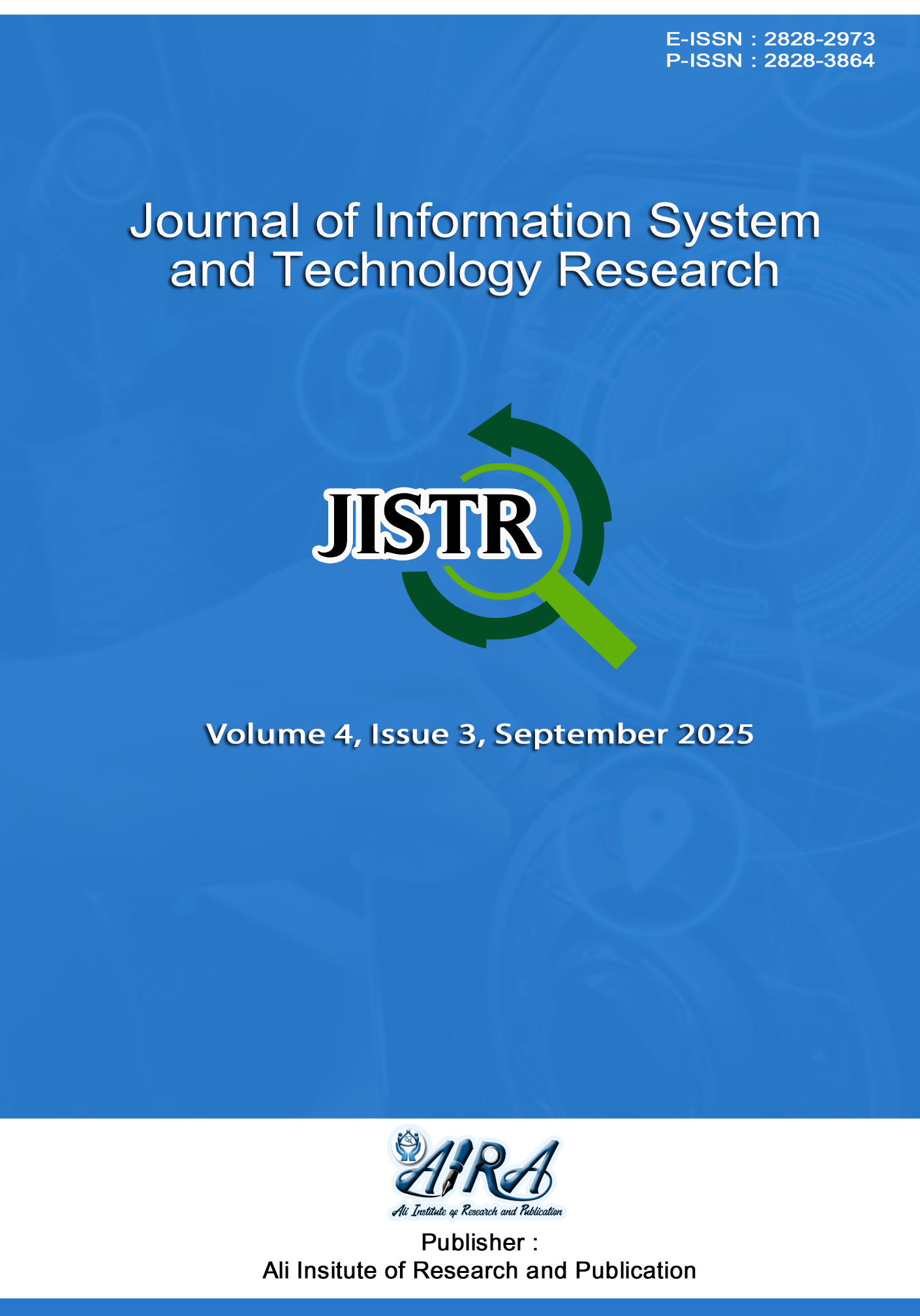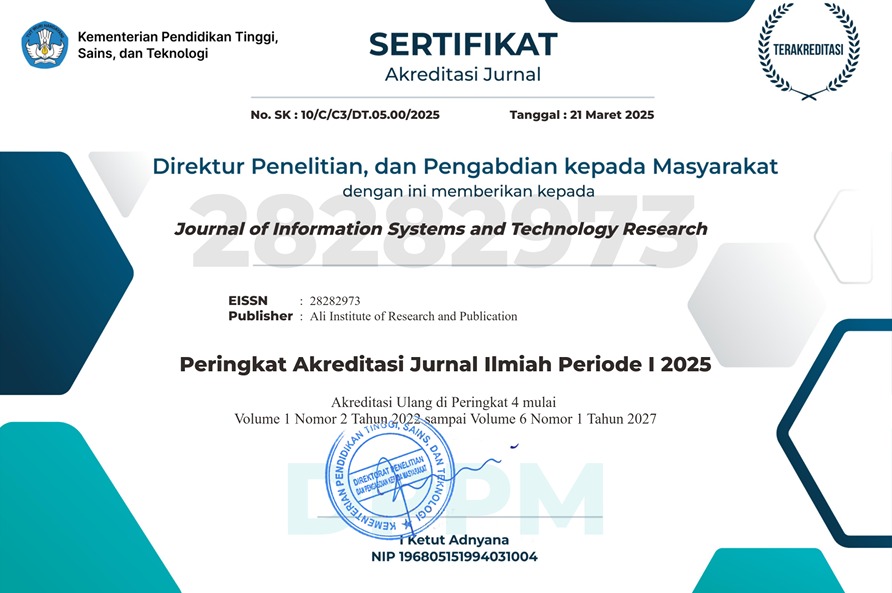Comparative Analysis of Deep Learning Models for Wind Speed Prediction Using LSTM, TCN and RBFNN
DOI:
https://doi.org/10.55537/jistr.v4i3.1298Keywords:
Wind Speed Forecasting, Long Short-Term Memory, Time Convolution Network, Radial Basis Function Neural Network, PredictionAbstract
Wind speed forecasting plays a vital role in various sectors, including renewable energy management and disaster preparedness for extreme weather events. Accurate prediction models are essential to support decision-making processes, especially in regions with dynamic seasonal patterns. This study compares the performance of three time series prediction models Long Short-Term Memory (LSTM), Temporal Convolutional Network (TCN), and Radial Basis Function Neural Network (RBFNN) for forecasting daily wind speed. The dataset consists of historical wind speed data that underwent multiple preprocessing steps, including seasonal-based missing value imputation, stationarity testing, supervised transformation, normalization, and hyperparameter tuning to optimize model performance. The models were evaluated using four standard regression metrics: Mean Absolute Error (MAE), Root Mean Square Error (RMSE), R-Squared (R²), and Mean Absolute Percentage Error (MAPE). The results show that the TCN model outperformed the others, achieving an MAE of 1.117, RMSE of 1.524, R² of 0.120, and MAPE of 20.95%. The LSTM model ranked second with competitive performance, while the RBFNN model produced consistent but slightly lower accuracy. The findings highlight the superiority of TCN in capturing complex sequential and seasonal patterns in wind speed data. The unique contribution of this research lies in integrating seasonal-based preprocessing with a comparative evaluation of three advanced models under varying conditions, including extreme weather scenarios. This study serves as a foundation for developing more accurate and reliable wind speed forecasting systems to support renewable energy planning and enhance disaster risk mitigation strategies.
Downloads
References
[1] S. ,. K. S. Abdul Malek, “Prediksi Kecepatan Angin Jangka Menengah dengan Artificial Neural Network untuk Estimasi Daya Listrik Tenaga Angin (Studi Kasus: Kota Sabang),” JSE , vol. 8, no. 3, pp. 6078-6087, 2023.
[2] A. M. Meftah Elsaraiti, “Application of Long-Short-Term-Memory Recurrent Neural,” Networks to Forecast Wind Speed, vol. 11, no. 2387, pp. 2-9, 2021.
[3] M. B. H. S. P. Nerfita Nikentari, “Prediksi Kecepatan Angin Menggunakan Adaptive Neuro Fuzzy (ANFIS) dan Radial Basis Function Neural Network (RBFNN),” JEPIN(Jurnal Edukasi dan Penelitian Informatika), vol. 4, no. 1, pp. 70-75, 2018.
[4] B. M. K. d. Geofisika, “Waspadai Potensi Kebakaran Hutan & lahan serta Krisis Air Bersih,” Buletin Stasiun Meteorologi Kelas I Juanda Sidoarjo, vol. 1, no. 9, pp. 1-30, 2020.
[5] B. M. K. d. Geofisika, “Waspada Cuaca di Puncak Musim Kemarau,” Buletin Stasiun Meteorologi Kelas I Juanda Sidoarjo, vol. 1, no. 8, pp. 1-33, 2020.
[6] S. Y. Nuril Martha Anggraeni, “Analisis Dampak Perubahan Iklim dan Pola Angin Pada Lingkungan Global,” Jurnal Pendidikan, Sains, dan Teknologi, vol. 2, no. 4, pp. 1041-1047, 2023.
[7] L. F. P. D. R. F. Melisa Sekar Fadila, “PREDIKSI KECEPATAN ANGIN HARIAN KOTA BANDAR LAMPUNG MENGGUNAKAN RECURRENT NEURAL NETWORK (RNN),” dalam Prosiding Seminar Nasional Sains dan Teknologi Seri 02, Lampung, 2024.
[8] M. B. ,. H. S. P. Nerfita Nikentari, “Prediksi Kecepatan Angin Menggunakan Adaptive Neuro Fuzzy (ANFIS) dan Radial Basis Function Neural Network (RBFNN),” Jurnal Edukasi dan Penelitian Informatika, vol. 4, no. 1, pp. 70-75, 2018.
[9] F. M. N. A. I. B. A. N. K. A. H. A. H. Haryas Subyantara Wicaksana, “Estimasi Kecepatan Angin Permukaan pada Jaringan Anemometer Menggunakan Temporal Convolutional Network,” Jurnal Otomasi Kontrol dan Instrumentasi, vol. 16, no. 1, pp. 44-52, 2024.
[10] A. M. P. A. R. Aviolla Terza Damaliana, “Peramalan Lonjakan Kasus Harian Covid-19 Di Indonesia Dengan Model Arima,” Seminar Nasional Sains Data , pp. 184-189, 2023.
[11] E. Supriadi, “ESTIMATION OF DAILY WEATHER DATA BY GENERATING MONTHLY DATA: NORTH SULAWESI CASE STUDY,” Jurnal Meteorologi dan Geofisika, vol. 24, no. 2, pp. 77-85, 2024.
[12] M. Z. D. N. S. M. P. N. B. A. M. H. Meida Yustiana, “VARIABILITAS CURAH HUJAN INDONESIA DAN HUBUNGANNYA DENGAN ENSO/IOD:ESTIMASI MENGGUNAKAN DATA JRA-25/JCDAS,” AGROMET, vol. 28, no. 1, pp. 1-8, 2014.
[13] M. Z. D. N. S. M. P. N. B. A. M. H. Meida Yustiana, “Dampak Variabilitas Iklim Inter-Annual (El Niño, La Niña) Terhadap Curah Hujan dan Anomali Tinggi Muka Laut di Pantai Utara Jawa Tengah,” Buletin Oseanografi Marina, vol. 12, no. 1, pp. 109-124, 2023.
[14] Z. L. D. M. A. M. Giarno, “KAJIAN AWAL MUSIM HUJAN DAN AWAL MUSIM KEMARAU DI INDONESIA,” JURNAL METEOROLOGI DAN GEOFISIKA, vol. 13, no. 1, pp. 1-8, 2012.
[15] A. F. E. Firmansyah, “PREDIKSI HARGA COIN CRYPTOCURRENCY BNB MENGGUNAKAN METODE AUTO REGRESSIVE INTEGRATED MOVING AVERAGE,” Ju rnal Ilmiah Teknologi Informasi dan Sains, vol. 4, no. 2, pp. 17-21, 2024.
[16] R. G. Farhan Mohammad Khan, “ARIMA and NAR based prediction model for time series analysis of COVID-19 cases in India,” Journal of Safety Science and Resilience, vol. 1, no. 1, pp. 12-18, 2020.
[17] ,. A. M. P. A. R. Aviolla Terza Damaliana, “Peramalan Lonjakan Kasus Harian Covid-19 Di Indonesia Dengan Model Arima,” dalam Seminar Nasional Sains Data , Jawa Timur, 2023.
[18] D. F. S. D. N. Haris Awarulloh, “Penggunaan Multivariat Model Bidirectional LSTM untuk Prediksi Cuaca: Optimalisasi Waktu Tanam Padi Petani Kabupaten Garut,” Jurnal Ilmiah Sinus (JIS) , vol. 23, no. 1, pp. 127-138, 2025.
[19] P. H. Irma Fitria, “Penerapan Algoritma Kalman Filter dalam Prediksi Kecepatan Angin di Kota Balikpapan,” SPECTA Journal of Technology , vol. 1, no. 2, pp. 25-32, 2017.
[20] Y. A. K. S. B. S. G. A. D. Siti Aisyah, “Technical Analysis of the Indonesian Stock Market with Gated Recurrent Unit and Temporal Convolutional Network,” JUITA: Jurnal Informatika, vol. 12, no. 2, pp. 187-196, 2024.
[21] J. M. P. W. a. P. S. Piyush Khandelwal, “Efficient Real-Time Inference in Temporal Convolution Networks,” dalam IEEE International Conference on Robotics and Automation , China, 2021.
[22] Y. G. T. J. X. W. F. Y. G. B. WENTIAN ZHAO, “Deep Temporal Convolutional Networks for Short-term Traffic Flow Forecasting,” IEEE, vol. 7, pp. 1-12, 2019.
[23] C. L. J. Z. G. T. Zhenhao Gan, “Temporal convolutional networks interval prediction model for wind speed forecasting,” Electric Power Systems Research, vol. 191, pp. 1-10, 2020.
[24] F. M. M. A. Aref Hashemi Fath, “Implementation of multilayer perceptron (MLP) and radial basis function (RBF) neural networks to predict solution gas-oil ratio of crude oil systems,” Petroleum, vol. 6, no. 1, pp. 80-91, 2020.
[25] X. Z. J. S. G. X. H. H. H. L. F. W. B.-Q. L. Ying Deng, “New methods based on back propagation (BP) and radial basis function (RBF) artificial neural networks (ANNs) for predicting the occurrence of haloketones in tap water,” Science of The Total Environment, vol. 772, pp. 1-9, 2021.
[26] L. S. A. F. Siti Khotijah, “Prediksi Harga Emas Menggunakan Metode Radial Basis Function Neural Network (RBFNN),” Jurnal Sains Matematika dan Statistika, vol. 10, no. 1, pp. 20-30, 2024.
[27] ,. E. A. H. D. A. P. R. A. P. D. P. A. Anggraini Puspita Sari, “SISTEM PREDIKSI KECEPATAN DAN ARAH ANGIN MENGGUNAKAN BIDIRECTIONAL LONG SHORT-TERM MEMORY,” Seminar Keinsinyuran , pp. 1-16, 2021.
[28] Q. W. F. Z. C. Y. Y. L. Hongqiu Zhu, “A prediction method of electrocoagulation reactor removal rate based on Long Term and Short Term Memory–Autoregressive Integrated Moving Average Model,” Process Safety and Environmental Protection, vol. 152, pp. 462-470, 2021.
[29] I. G. P. A. B. M. T. P. R. M Idhom, “Antithesis of Human Rater: Psychometric Responding to ShiftsCompetency Test Assessment Using Automation (AES System),” Studies in Learning and Teaching(SiLeT), vol. 4, no. 2, pp. 329-340, 2023.
Downloads
Published
How to Cite
Issue
Section
License
Copyright (c) 2025 Firly Setya Wardani, Mohammad Idhom, Aviolla Terza Damaliana

This work is licensed under a Creative Commons Attribution-ShareAlike 4.0 International License.







